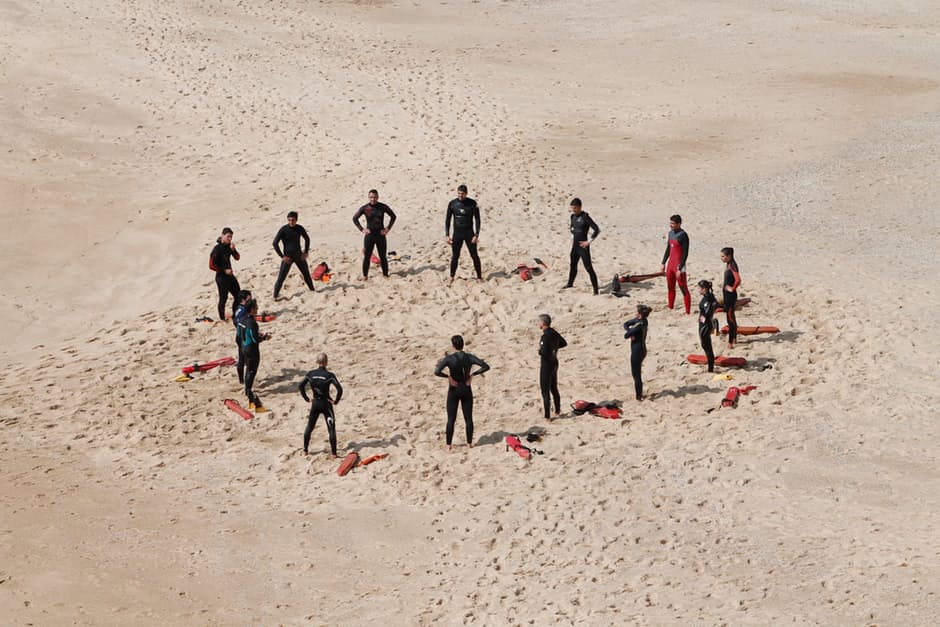
Photo by Christian Stahl on Unsplash
The Daily Scrum Meeting is for me one of the most controversial Agile practices. Indeed, being both one of the most popular elements for the teams, it is also the one who can create the most frustration for them.
The reason is quite simple: its intention is not always clear, which easily leads to a drift in its use.
I propose here to describe an alternative to the Daily Scrum Meeting as we can usually know it, in the hope that this will open up the field of options for your current use.
Good reading !
Why change?
When I meet a new team, it's quite rare that they haven't heard of the Daily Scrum Meeting.
It is then a good opportunity for me to ask how it happens in order to start from their own experience of the subject.
Here are the patterns I often find:
1. An incomplete protocol

When I ask how the team conducts its DSM, they often explain to me that itEach member answers these 3 questions in turn:
- What did I do yesterday?
- What am I going to do today?
- What problems am I encountering?
Unfortunately, this protocol is incomplete and is a clumsy simplification of the example protocol described in the Scrum Guide.
| Scrum Guide (Nov 2017)
The protocol described is as follows:
|
2. A reporting meeting

Indeed, the questions formulated as above are self-centered:
- What do I have (Me) done yesterday ?
- What is (Me) am I going to do today?
- What are the problems that (Me) I meet ?
This tends to turn the DSM into reporting meeting where everyone tells their own story rather than taking part in a common story lived together.
Note: I even hear sometimes that this causes some stress for the participants who may feel pressured to have something to say. Everyone then thinks about what they are going to say in their own corner rather than listening to the others – there is then a risk of drowning out the real important information to be passed on to the team.
| Scrum Guide (Nov 2017)
By using the official formulation of the example protocol, 2 additional concepts are highlighted:
|
It is important to emphasize that the reporting meeting is moreover a drift from the original intention of the DSM.
I would also like to point out to this effect that:
Reporting is usually more valuable
for the person who receives it than for the person who realizes it.
| Scrum Guide (Nov 2017)
“The Daily Scrum is an event […] for the development team. » The DSM is therefore an event that must have value for the development team above all. This can therefore in no way be a reporting meeting to other bodies. “The development team is planning their activities there for the next 24 hours. » The original intention of the DSM is to promote theinspection and adaptation of the development team – self-organized – in order to reach its sprint goal. " It highlights and promotes quick decisions. This is a key meeting of inspection and adaptation. » It is a meeting of synchronization and collective decision-making first of all. The important thing is to agree on what is most relevant to achieve together today to increase your chances of not missing the target. |
3. Positioning in a closed circle

One way to reinforce the effect of the reporting meeting: stand in a circle and look each other in the eye!
Why is this a problem?
If we look at the field of sport (football, basketball, rugby, etc.), the objective of these groupings is above all to restore forward momentum rather than to look back. The information is therefore simple so that the strategy is easy to understand in the allotted time and the implementation is as smooth as possible.
In the context of complex projects such as software development for example, even if we can be attentive to the first 2 or 3 people who speak, it is nevertheless difficult to keep in mind all the information that will be shared by the potential 8 other members of the team, while keeping in view the objective to be achieved. From what I have been able to see in my interventions, most of the time when the participants are in a circle, they are more in a phase of waiting for their turn to speak rather than actively listening to the whole group.
This emphasizes once again the individual dimension of the work: each one speaks in turn to say what he has done without having a global vision of the work to be provided and the way in which each contributes to this whole.
|
It is important that the whole team is aligned with the current situation: this is why we use Visual Management. It's not for nothing that his main motto is: “See Together – Act Together – Learn Together” Scrum Guide (Nov 2017) “Every day, members of the Development Team come to understand how which they intend to work together as a self-organizing team to achieve the Sprint Goal. » Providing visual support is a simple and practical way to materialize the current situation and help the team make better decisions together. As a result, it continues to learn from its operation and can more easily focus its improvement efforts based on the same global vision of their common history. The placement should then rather resemble an arc in front of the Visual Management. |
4. A meeting that lasts

We sometimes hear that DSMs last 1 hour each day (usually for the reasons mentioned earlier). It often happens that problems are discussed during the DSM, which generates a number of additional discussions that do not concern all the participants of the team.
It's important to keep in mind that all Scrum events are timeboxed for a reason: learning from frustration to do better next time. Not respecting these timeboxes is simply preventing yourself from learning and improving.
| Scrum Guide (Nov 2017)
“The Daily Scrum is a time-boxed event of 15 minutes for the Development Team. » |
A reason for the meeting to last is also the number of people. It often happens that the number of people recommended in a development team is exceeded, which naturally implies an extension of the time if we keep the initial protocol where everyone must absolutely speak.
| Scrum Guide (Nov 2017)
“The optimal size of the Development Team should be small enough to remain responsive and large enough to do meaningful work during a Sprint. Below 3, members of the Development Team lose in interaction and this generates low productivity gains. […] To have more than nine members request too much coordination. » |
It was therefore time to do otherwise, this is what I propose to you in the rest of this article! 😉
An alternative: the Daily Kanban
You will tell me that once again it is a Scrum VS Kanban comparison that I am making here. Well yes, but no.
- Yes, because it is indeed the protocol of the Daily Kanban Meeting that I will describe to you with the advantages that I find there to respond to the usual drifts of the DSM.
- No, because the Scrum VS Kanban debate makes no sense to me. Rather than separate, today I prefer to integrate the best of both.
And as I said in my article on a variant of ROTI :
It's not the tool or the method that matters,
but the way we use it and what it can bring us.
Here is the protocol that I propose today to the teams that I accompany.
Daily Protocol
Initial conditions :
- Positioning of the team in an arc of a circle in front of its Visual Management
- Timebox set to 15 minutes
- A person is facilitating
Step 1: Align with the current situation

|
Is the table up to date? |
The object here is to make sure that we see the current situation: if the tasks have not been moved before the Daily, now is a good time to do so. So here we have information on what people worked on the day before, which normally does not need to be mentioned again.
We then move on to step 2.
Ratings :
|
Step 2: Alert

|
Are there any points of attention to report to the team? (Important information, blockers, emergencies…) |
- Emergencies that have just fallen
- Blockages that have lasted for a long time
- Upcoming entrants that deserve the team's attention
Then ask if everyone knows what is most important to achieve today and how they will contribute:
- whether yes (everyone knows what to do today), close the Daily
- whether no (not everyone knows what to do exactly today), we go to the 3rd step
Ratings :
|
Step 3: Browse

|
[Scroll the table from right to left] |
If we have gone beyond the previous step, we will "Walk the board" as our Anglo-Saxon friends would say by going through the elements of the table, and that from right to left.
Why from right to left?
Usually, Visual Management charts describe a process that goes from left to right.
(I specify this because by playing the workshop “ To the blackboard“, I have already had cases where the process went from right to left or even from top to bottom or in a spiral! :-D)
“Stop Starting, Start Finishing”
By traversing the array from the end to the beginning, we look at the elements that are closest to the exit in order to increase the chances of completing them.
What can be discussed on the elements covered:
- Current progress
- Important information to share with the team about this
- Problems encountered
- Request help to complete the item
As for the DSM, the idea is not to go into details but to transmit information or to explain a problem (not to solve it). Indeed, the search for solutions is done immediately after the DSM with the people involved or concerned.
The more mature we become in the use of the Daily Kanban, the more we only talk about the problems encountered to synchronize the team and take action.
Each time the columns are moved, we ask if everyone knows what is most important to achieve today and how everyone will contribute to it.
- Whether yes (everyone knows what to do today), we close the Daily
- Whether no (not everyone knows what to do exactly today), we continue to traverse the table
Ratings :
|
Conclusion
Since I discovered the Daily Kanban Meeting, it's been hard for me to go back.
Indeed, it responds in a natural way to different problems:
- The protocol is simple to follow and is based on transparency for better collective decision-making
- I'flow orientation naturally focuses attention on the collective objective rather than on individual objectives
- Facilitation by a person gives dynamism in the meeting. Moreover, since we focus on work and not on people, we reduce the feeling of reporting or policing of everyone.
- THE timing is more easily respected for large groups: a team of 20 people can easily hold the 15 minutes when they are used to the protocol 😉
In short, I invite you to try it out and give me some news because to try it is to adopt it! 🙂







4 responses
Hello Oliver,
Martin Fowler had made an article on different possible patterns, Cf. https://www.martinfowler.com/articles/itsNotJustStandingUp.html
In the Scrum Guide 2017, it is written that the 3 "classic" questions are only an example of a usable pattern.
In the Kanban Guide for Scrum Team 2018, it is proposed to make a "Flow based Daily Scrum" close to what you propose.
Cordially
Olivier
Hello Oliver,
Thanks for the information ! 🙂
Best regards,
Olivier
Thank you, I particularly appreciate the precision with which you describe the daily kanban protocol.
Speaking of processes in different orientations, I myself have experimented with flipping my personal kanban. I saw immediate and unsuspected effects! It naturally puts more focus on 'start finishing, stop starting' (more details here https://philippe.bourgau.net/its-time-to-flip-your-kanban-board-setup/) To the point where I wonder if we shouldn't reorient our paintings more often?
Thank you for this post I will try to make my team try this.